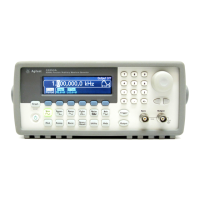176
Chapter 4 Remote Interface Reference
Frequency-Shift Keying (FSK) Commands
4
Frequency-Shift Keying (FSK) Commands
See also “FSK Modulation” starting on page 78 in chapter 3.
FSK Overview
The following is an overview of the steps required to generate an FSK
modulated waveform. The commands used for FSK are listed on the
next page.
1 Configure the carrier waveform.
Use the APPLy command or the equivalent FUNC, FREQ, VOLT, and
VOLT:OFFS commands to select the function, frequency, amplitude, and
offset of the carrier waveform. You can select a sine, square, ramp, or
arbitrary waveform for the carrier (pulse, noise, and dc are not allowed).
2 Select the FSK source.
The function generator will accept an internal or external FSK source.
Select the FSK source using the FSK:SOUR command.
3 Select the FSK “hop” frequency.
Set the alternate (or “hop”) frequency to any value from 1 µHz to
80 MHz
(limited to 1 MHz for ramps and 25 MHz for arbitrary waveforms
) using
the FSK:FREQ command.
4 Set the FSK rate.
Set the FSK rate to any value from 2 mHz to 100 kHz using the
FSK:INT:RATE command (internal FSK source only). The FSK rate
sets the pace at which the output frequency “shifts” between the
carrier frequency and the hop frequency.
5 Enable FSK modulation.
After you have set up the other FSK parameters, use the FSK:STAT ON
command to enable FSK modulation.

